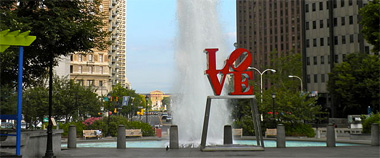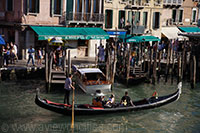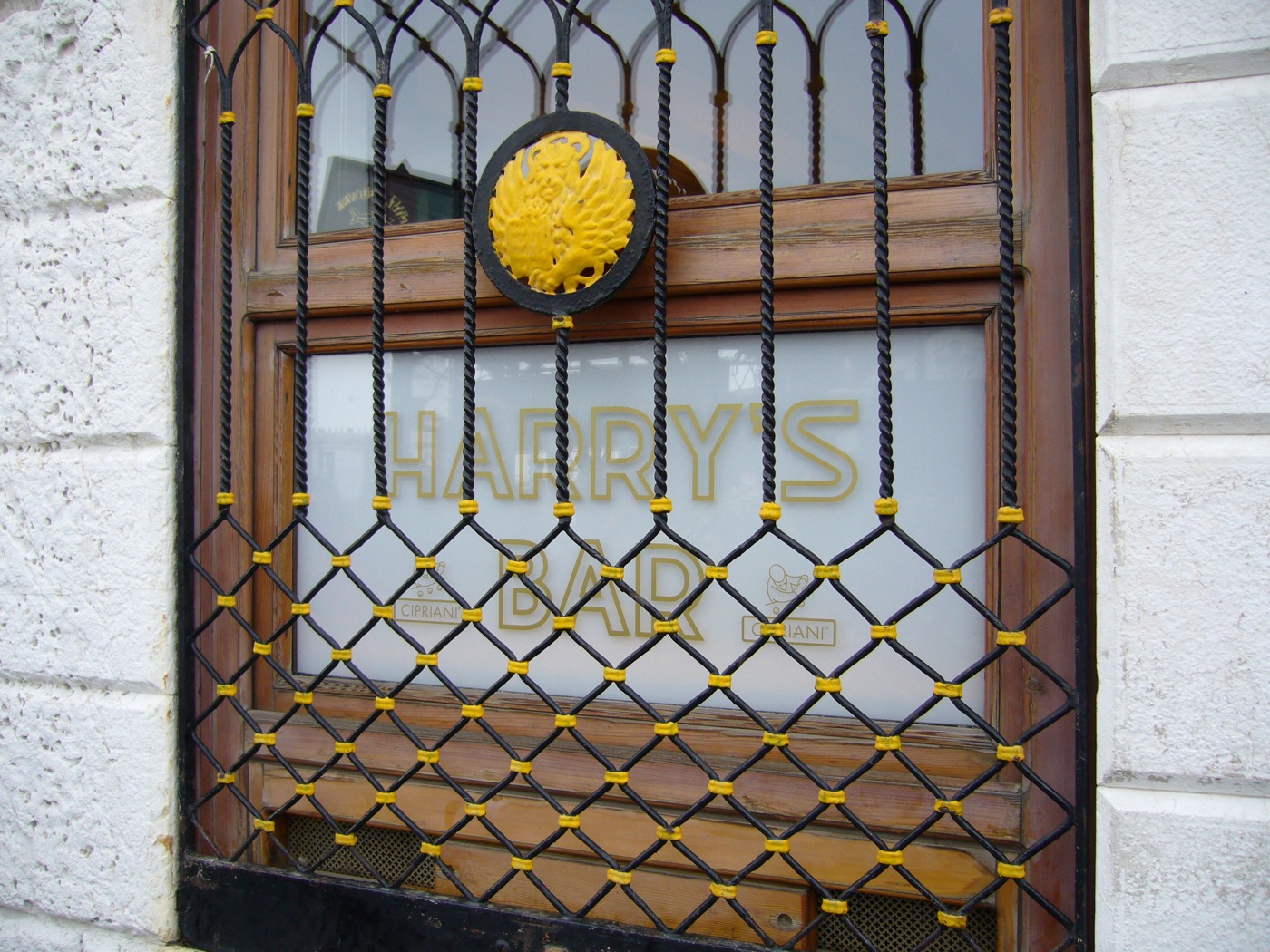"It is a handsome city, but distractingly regular. After walking about it for an hour or two, I felt that I would have given the world for a crooked street. The collar of my coat appeared to stiffen and the brim of my hat to expand, beneath its Quakerly influence."
Charles Dickens
 |
| Philadelphia |
| Betsy Ross' house |
The main things I did that day were to visit the best known sights of the city. I remember I paid to take a walking tour called "Walking in Franklin's Footsteps," which took me to Independence Hall, the Liberty Bell, Betsy Ross' house and to the Christ Church cemetery where Benjamin Franklin, and several other signers of the constitution, are buried. We all threw a penny on Franklin's grave - it has become a tradition to do this, because of his saying "a penny earned, is a penny saved."
 |
| Franklin's Grave |
There are many other city tours available, including bus tours where you can hop on and off all day. Those are nice because they tell you what you are seeing, and they save on walking. There are also carriage tours, and tours on the trolley - which is an open air Victorian-style trolley, which has 20 stops throughout the city and is also hop on and off. And there are some nighttime tours available.
If you are doing the city on your own and not taking a tour then the following are the main sights to see while visiting the city:
Independence Hall
here that the Declaration of Independence and the Constitution were debated, drafted and signed by our forefathers. While touring Independence Hall, you'll have the chance to see the Assembly Room where George Washington was appointed commander in chief of the Continental Army. You can also see surviving copies of the declaration, the Constitution and the Articles of Confederation, all displayed in the West Wing's Great Essentials Exhibit. From March through December, you must obtain a ticket for a tour to visit Independence Hall (tickets are free, but there is a $1.50 ticket-handling fee). You don't need a ticket to visit in January and February, but you must join a guided tour. Independence Hall is open daily with tours beginning at 9 a.m. Generally, the final tour is given around 5 p.m. although they often continue later in the summer.
Liberty Bell Center
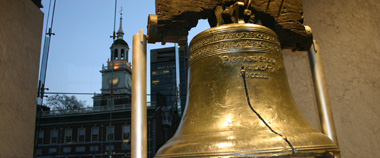 Now residing in a huge glass gazebo, this 2,080 pound piece of history was mounted in the belfry of Independence Hall. It was used to mark important historic events, most notably at the first public reading of the Declaration of Independence. Its chimes were last heard in 1846 for George Washington's birthday. It was around that time that the bell's famous crack was formed, rendering it unusable. The bell is on display, with Independence Hall in the background. The center is open year-round from 9 a.m. to 5 p.m. although hours may vary depending on the season. Admission is free. A video presentation and exhibits trace the bell’s history from its debut at the Pennsylvania State House to its use as a symbol of freedom by abolitionists, and the women’s suffrage and civil rights movements.
Now residing in a huge glass gazebo, this 2,080 pound piece of history was mounted in the belfry of Independence Hall. It was used to mark important historic events, most notably at the first public reading of the Declaration of Independence. Its chimes were last heard in 1846 for George Washington's birthday. It was around that time that the bell's famous crack was formed, rendering it unusable. The bell is on display, with Independence Hall in the background. The center is open year-round from 9 a.m. to 5 p.m. although hours may vary depending on the season. Admission is free. A video presentation and exhibits trace the bell’s history from its debut at the Pennsylvania State House to its use as a symbol of freedom by abolitionists, and the women’s suffrage and civil rights movements.National Constitution Center
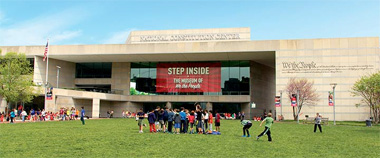 Located on Philadelphia’s Independence Mall, this nonprofit, nonpartisan institution invites visitors to immerse themselves in the Constitution, its history and its ongoing significance. Visitors will be dazzled by "The Story of We the People", an exhibit with more than 100 multimedia elements, and by Signers’ Hall, where they can walk among 43 life-size bronze statues of the Founding Fathers who were present the day the Constitution was signed.
Located on Philadelphia’s Independence Mall, this nonprofit, nonpartisan institution invites visitors to immerse themselves in the Constitution, its history and its ongoing significance. Visitors will be dazzled by "The Story of We the People", an exhibit with more than 100 multimedia elements, and by Signers’ Hall, where they can walk among 43 life-size bronze statues of the Founding Fathers who were present the day the Constitution was signed.
Christ Church Burial Ground
The Franklin Institute
 Named in honor of Benjamin Franklin, the institute is one of the country's best science museums. It houses exhibits ranging from the world's largest artificial heart (a walk-through mega pump that would be of accurate size for a 220 foot tall person) to a massive Baldwin 6000 steam locomotive. It also has a planetarium which highlights our skies and the universe beyond.
Named in honor of Benjamin Franklin, the institute is one of the country's best science museums. It houses exhibits ranging from the world's largest artificial heart (a walk-through mega pump that would be of accurate size for a 220 foot tall person) to a massive Baldwin 6000 steam locomotive. It also has a planetarium which highlights our skies and the universe beyond.
Museum of Art
 The Philadelphia Museum of Art is the third largest art museum in the country, and a must-see on the list of things to do in the city. It sits majestically on a rise at the end of the Benjamin Franklin Parkway, and reminds one of the Parthenon. The vast collections of art include holdings in Renaissance, American, Impressionist and Modern art. Upstairs, breathe in other cultures and times through over 80 period rooms, from the medieval cloister to the Indian temple.
The Philadelphia Museum of Art is the third largest art museum in the country, and a must-see on the list of things to do in the city. It sits majestically on a rise at the end of the Benjamin Franklin Parkway, and reminds one of the Parthenon. The vast collections of art include holdings in Renaissance, American, Impressionist and Modern art. Upstairs, breathe in other cultures and times through over 80 period rooms, from the medieval cloister to the Indian temple.
This cemetery is one of America’s most interesting Colonial and Revolution-era graveyards, with 1,400 markers on two beautiful acres right in the heart of historic Philadelphia. The Burial Ground is the final resting place of some of our most prominent leaders including Benjamin Franklin and four other signers of the Declaration of Independence. The Burial Ground is open March-Nov. (weather permitting). Hours are: Monday-Saturday 10-4, Sunday 12-4. Don't forget to throw a penny on Franklin's grave, its a Philadelphia tradition.
The Franklin Institute
 Named in honor of Benjamin Franklin, the institute is one of the country's best science museums. It houses exhibits ranging from the world's largest artificial heart (a walk-through mega pump that would be of accurate size for a 220 foot tall person) to a massive Baldwin 6000 steam locomotive. It also has a planetarium which highlights our skies and the universe beyond.
Named in honor of Benjamin Franklin, the institute is one of the country's best science museums. It houses exhibits ranging from the world's largest artificial heart (a walk-through mega pump that would be of accurate size for a 220 foot tall person) to a massive Baldwin 6000 steam locomotive. It also has a planetarium which highlights our skies and the universe beyond.Museum of Art
Reading Terminal Market
When it comes to satisfying your appetite in Philly, you can only eat so many cheese steaks. So when lunchtime rolls around, head to the Reading Terminal Market in the Market East District. This market is located beneath the Reading Railroad's 1891 train shed and harbors almost 100 different vendors. Here, you can sample food from around the world -- including Greek, Thai, Mexican and Indian specialties -- while perusing homemade crafts and jewelry. While there is a central dining area, many of the food stalls also have their own seating. The Reading Terminal Market is open Monday through Saturday from 8 a.m. to 6 p.m. and Sunday from 9 a.m. to 5 p.m.
Love Park (John F. Kennedy Plaza)
After lunch, go relax and do some people-watching in Love Park. Located across from City Hall, this urban plaza is a welcoming oasis for Center City workers on lunch breaks, families drawn by the soothing sounds of the large fountain, and even a few skateboarders willing to flout city law. The park takes its nickname from the iconic Robert Indiana Pop art sculpture found there.
Please Touch Museum
 If you are visiting the city with children, then this is a must see museum. Many say this children's museum is one of the best in the country. If offers dozens of hands-on displays, related to everything from fine arts to construction zones. You and the kids can travel to Wonderland with Alice, practice your reading skills in the Story Castle and hone your science skills in the lab. There are daily arts and crafts projects, and a café on the premises (with healthy snacks that your kids will love). It is open Monday through Saturday from 9 a.m. to 5 p.m. and Sunday from 11 a.m. to 5 p.m. Admission is $15 per person.
If you are visiting the city with children, then this is a must see museum. Many say this children's museum is one of the best in the country. If offers dozens of hands-on displays, related to everything from fine arts to construction zones. You and the kids can travel to Wonderland with Alice, practice your reading skills in the Story Castle and hone your science skills in the lab. There are daily arts and crafts projects, and a café on the premises (with healthy snacks that your kids will love). It is open Monday through Saturday from 9 a.m. to 5 p.m. and Sunday from 11 a.m. to 5 p.m. Admission is $15 per person.Chinatown
Philadelphia’s Chinatown is one of many Chinatowns in the United States, with culture and history, and it is certainly worth stopping by and seeing this area. You can visit some of the most historical and important buildings to the Chinese community, look at brilliant and breathtaking art and sculptures done by Chinese artisans, or take a stroll through the streets while window shopping and people-watching. There are wonderful shops to explore, as well as some great restaurants to get some Chinese food.
There are of course many other things to see in the city. There are many more museums. You can visit the oldest zoo in the country, or take in a play at the Walnut Street Theatre which is the oldest continuously operating theatre in the English-speaking world and the oldest in the United States. You could hang out in Franklin Square where legend has it Franklin conducted his famous "kite and key" experiment in 1752 and has a statue commemorating the event. Or you could take a walk through the Morris Arboretum on the grounds of the University of Pennsylvania.
| Philly Cheesesteak |
Whatever you decide to do while visiting this city, relax and enjoy the atmosphere, and remember that this is the birthplace of our country.


